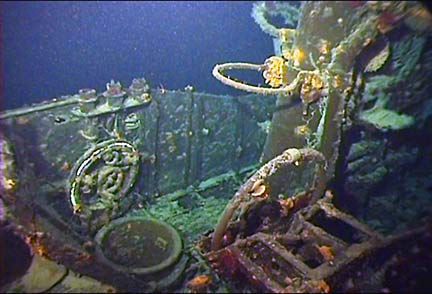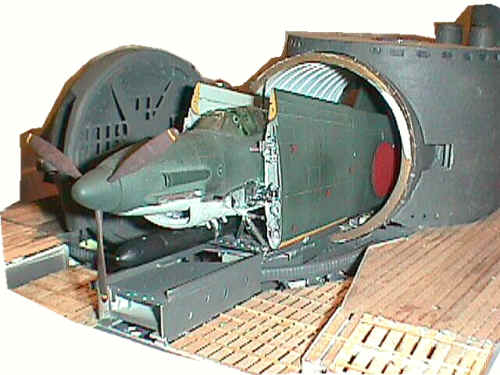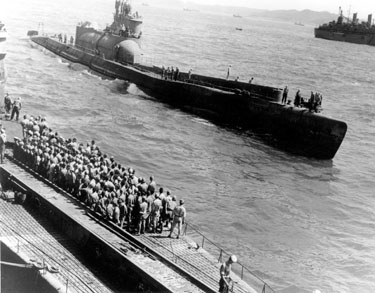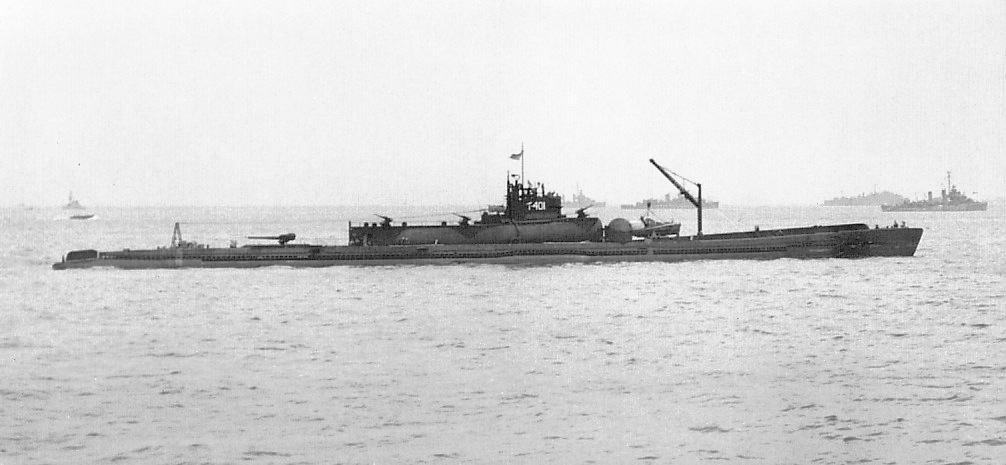UH team locates huge Japanese sub
Researchers discover the wreckage of a giant underwater
aircraft carrier scuttled after WWII
Exploring the South Pacific By Burl Burlingame
bburlingame@starbulletin.com
http://starbulletin.com/2005/03/20/news/story1.html
The deep-diving scientists of the University of Hawaii have discovered another monster lurking in the waters off Oahu.
During test dives Thursday, the Hawaii Undersea Research Laboratory’s Pisces submarines found the remains of the Imperial Japanese Navy’s I-401 submarine, a gigantic underwater aircraft carrier built to bomb the Panama Canal.
“We thought it was rocks at first, it was so huge,” said Pisces pilot Terry Kerby. “But the sides of it kept going up and up and up, three and four stories tall. It’s a leviathan down there, a monster.”
It is not the first World War II-era “monster” that the HURL scientists have found. Last year, off Pearl Harbor, they located the wreck of the gigantic seaplane Marshall Mars, one of the largest aircraft built and used as a transport plane by the U.S. Navy. Two years earlier in the same area, the HURL crew also found the wreckage of a Japanese midget sub that was sunk on Dec. 7, 1941.
The latest HURL discovery is from the I-400 “Sensuikan Toku” class of submarines, the largest built prior to the nuclear ballistic missile submarines of the 1960s. They were 400 feet long and 39.3 feet high, could reach a maximum depth of 330 feet, and carry a crew of 144.
HAWAII UNDERSEA RESEARCH LAB
An undersea photo reveals the bridge of the Imperial Japanese Navy’s I-401 submarine. The Hawaii Undersea Research Laboratory’s Pisces submarines discovered the “monster” in waters off Kalaeloa on Thursday.
Each carried three fold-up bombers inside a watertight hangar, plus parts to construct a fourth airplane. The bombers, called Seiran or “Mountain Haze,” could be made ready to fly in a few minutes and had wing floats for return landings. Fully loaded with fuel, the submarines could sail 37,000 miles, one and a half times around the world. Three were captured at the end of the war, as well as a slightly smaller test design called the I-14.
Their first mission was called “Operation PX,” a plan to use the aircraft to drop infected rats and insects with bubonic plague, cholera, dengue fever, typhus and other diseases on American West Coast cities. When the bacteriological bombs could not be prepared in time, the target was changed to the Panama Canal.
I-400 and I-401 were captured at sea a week after the Japanese surrendered in 1945. The commander committed suicide and the huge submarines’ mission was never completed.
I-400, I-401 and I-14 were ordered to sail to Pearl Harbor in late 1945 with an American prize crew, who smuggled Japanese war souvenirs in the aircraft hangars. Also along to be evaluated were I-201 and I-203, two top-secret Imperial Navy submarines that were twice as fast as American designs.
The submarines were greeted with ceremonial brass bands in early 1946, but within a few months it was decided to scuttle the Japanese designs, partly because Russians scientists were demanding access to them. On May 31, 1946, I-401 and the other four top-secret Japanese submarines were sunk by torpedoes from the American submarine USS Cabezon. I-401 was last seen sinking by the stern, vanishing until last week.
“It’s about 820 meters down, off the coast of Barbers Point,” said HURL Acting Director John Wiltshire. “The bow is broken off just forward of the aircraft hangar – it looks like it came apart as it was sinking, as the two pieces aren’t far apart and they’re connected by a debris field.”
According to Pisces VI pilots Kerby and Colin Wolleman, the “debris field” is a twisted landscape of gigantic metal pieces ripped into jagged shreds.
“We had to be very careful approaching that thing,” said Wolleman.
Nearby, the Pisces V crew consisted of John Smith, Max Cremer and Steve Price, and the submersibles helped each other illuminate a path through the wreckage.
“The main hull is sitting upright on the bottom, and it’s in great shape,” said Kerby. “The I-401 numbers are clearly visible on the sides of the conning tower, and the antiaircraft guns are in almost perfect condition.”
With only a few hours available before setting off on a research trip to Samoa, the HURL scientists noted the location of the I-401 for future exploration.
additional links:
http://www.pacerfarm.org/i-400/
http://www.combinedfleet.com/I-400.htm
http://www.afa.org/magazine/march2004/0304sub.asp
http://steelnavy.com/I400.htm




















